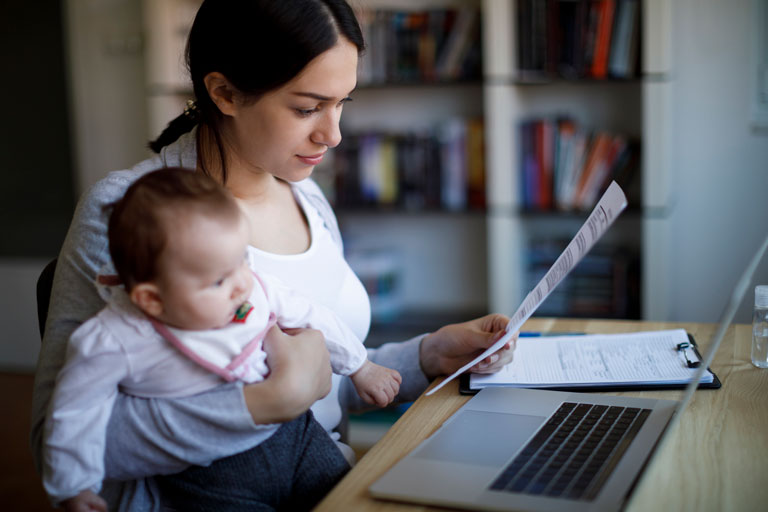May 21, 2020
Moms have long been considered the glue that holds families together. They often take on more responsibility when it comes to childcare and household chores, and they tend to be the decision makers in the family.
IU researchers are focusing on mothers to determine how families are coping with the COVID-19 pandemic, information which can help health officials determine best strategies to help curb the virus.
"Mothers are the key to family health – the ones who make health decisions and the ones who are most connected to healthcare providers," said Amy Knopf, assistant professor in the IU School of Nursing at IUPUI and co-PI of the Pandemic Parenting Study. "So, by focusing on mothers, we are getting a good look at how public health is shaped."
The Pandemic Parenting Study pulls from an existing cohort study of parenting practices of 250 mothers of young children living in Monroe County, Indiana, led by Jessica Calarco, associate professor of sociology at IU Bloomington.
The researchers used surveys, in-depth interviews and daily diaries of social contact taken in April 2020 to learn more about mothers' preferred sources of information about the pandemic and public health recommendations for prevention; examine how mothers of young children interpret social distancing guidelines; identify barriers to practicing social distancing; and describe the impact of social distancing policies and practices on family life and parenting, especially among mothers with limited resources.
Preliminary data found that most mothers, 62 percent, are extremely concerned or very concerned about the virus and over half, 56 percent, are closely following news about the virus. When it comes to resources for such information, most mothers are turning to public health agencies, their spouses/partners and news media for information. However, they considered the most trusted news sources to be public health agencies, spouses/partners and family healthcare providers.
“It is interesting because mothers tend to turn to news for information, but they do not consider it the most trusted source of information,” Calarco said. “On the flip side, they do trust information from healthcare providers, but they are not turning to that source for information as often, likely because of concerns about visiting healthcare facilities during a pandemic.”
When it comes to reducing risks associated with the virus, 58 percent of mothers reported they had not had close contact with anyone outside their household in the last week. However, 84 percent reported they had left their house in the past week to go to the grocery store, to a restaurant, the pharmacy, the doctor or for a walk outside.
In terms of precautionary steps taken to avoid the virus, most practice frequent handwashing, use hand sanitizer and cover coughs and sneezes. Less common steps taken were wearing a mask in public, avoiding public places entirely and avoiding leaving home at all.
Social distancing has been one of the keys to curbing the coronavirus, which has left many families struggling to balance work and childcare.
“Mothers have long done an unequal share of childcare, compared to fathers, and the pandemic is no different,” Calarco said. “With schools and daycares closed, the pandemic has caused tremendous changes in mothers’ childcare responsibilities, which according to the study, are taking a tremendous toll on mothers’ relationships and wellbeing.”
Of mothers with at least one child under 2 years-old, 68 percent reported they are spending either a great deal more, or somewhat more, time caring for their children than they did before the pandemic. A total of 80 percent of women who worked prior to the pandemic reported spending more time caring for their children compared to 45 percent of women who were stay-at-home moms before the pandemic.
Some mothers are spending more time with their kids because their partners are essential workers, some lost their jobs or had their hours reduced and others are simply having a hard time negotiating a good balance of childcare with their spouse/partner while working at home.
These changes are causing a significant increase in stress for mothers of young children and are exacerbated in situations where mothers feel that their spouses/partners are not doing enough to help with the new childcare responsibilities.
“Mothers of young children who report spending more time on childcare in the wake of the pandemic are reporting a significantly larger increase in stress than mothers who are providing the same amount of childcare as before,” Calarco said. “Interestingly enough, mothers of young children who are spending somewhat less time with their children are also reporting significantly more stress."
Project interviews suggest that, for those mothers, the added stress is largely a function of mothers’ work responsibilities. Most of the mothers now spending less time with their children are essential workers, and those mothers worry that, in leaving the house for work, they will expose their families to greater health risks.
Ultimately, these preliminary findings suggest that the pandemic is creating significant challenges for mothers of young children. Those challenges, in turn, have the potential to threaten mothers’ well-being, their relationships with their spouses/partners, and also their careers.
“Mothers of young children are already disadvantaged in the workplace,” Calarco said. “And this pandemic appears to be threatening the gains the women have made in recent years.”
Interview data from the project revealed that some mothers who previously worked outside the home are considering quitting their jobs scaling back their work hours so that they can continue providing full-time care or even homeschooling for their children long-term. Those mothers are concerned about the health risks of sending their children to schools and childcare centers. Some also expressed concerns about the potential safety of a “fast-tracked” coronavirus vaccine.
Calarco and Knopf will follow up with the parents in mid-summer and late fall to see how their decision making is changing as restrictions due to the coronavirus ease and states and the country continue to reopen.
“Looking at the ways families, particularly mothers, make decisions during times like this can help us determine what messaging is necessary and what source mothers will turn to in protecting themselves and in turn, their communities,” Calarco said.




